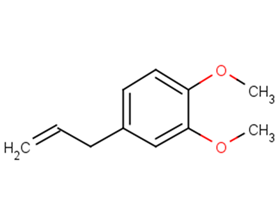
Methyl eugenol
CAS No. 93-15-2
Methyl eugenol( Methyleugenol | Methyl eugenol | Eugenol methyl ether )
Catalog No. M19264 CAS No. 93-15-2
Methyleugenol (ME) is a natural constituent of the essential oils of a number of plants widely used in foodstuffs as flavouring agents.
Purity : >98% (HPLC)
 COA
COA
 Datasheet
Datasheet
 HNMR
HNMR
 HPLC
HPLC
 MSDS
MSDS
 Handing Instructions
Handing Instructions
| Size | Price / USD | Stock | Quantity |
| 100MG | 35 | In Stock |


|
| 200MG | Get Quote | In Stock |


|
| 500MG | Get Quote | In Stock |


|
| 1G | Get Quote | In Stock |


|
Biological Information
-
Product NameMethyl eugenol
-
NoteResearch use only, not for human use.
-
Brief DescriptionMethyleugenol (ME) is a natural constituent of the essential oils of a number of plants widely used in foodstuffs as flavouring agents.
-
DescriptionMethyleugenol (ME) is a natural constituent of the essential oils of a number of plants widely used in foodstuffs as flavouring agents, in view of the carcinogenic potential of ME, the need to check its presence in food products with effective analytical methods. Methyleugenol has insecticidal properties. Methyleugenol can inhibit the production of nitric oxide and decreased the protein expression of inducible nitric oxide synthase, it down-regulates the production of pro-inflammatory cytokines in the ischemic brain as well as in immunostimulated mixed glial cells; indicates that methyleugenol could be useful for the treatment of ischemia/inflammation-related diseases. Methyleugenol has cytotoxicity and genotoxicity. Intravenous (i.v.) treatment with methyleugenol (ME) in either anesthetized or conscious rats elicits hypotension, an effect that seems related to an active vascular relaxation rather than withdrawal of sympathetic tone. Methyleugenol has antinociceptive effect on the second phase of formalin-induced pain, may be due to the inhibition of N-methyl-d-aspartic acid (NMDA) receptor-mediated hyperalgesia via GABA(A) receptors. Methyleugenol has elaxant and antispasmodic actions on guinea-pig isolated ileum.
-
In VitroCell Autophagy Assay Cell Line:RB355 (Human retinoblastoma cells)Concentration:50 μM Incubation Time:24 h Result:Significantly increased the expression of LC3-II in a dose-dependent manner and decreased the expression of p62.Weakened the inhibitory effect of the autophagy inhibitor gastrostatin.Western Blot Analysis Cell Line:RB355 (Human retinoblastoma cells) Concentration:50 μM Incubation Time:48 h Result:Inhibited the PI3K/mTOR/Akt signaling pathway.Down-regulated the expression of m-TOR and pm-TOR proteins in a concentration-dependent manner.Down-regulated the expression of PI3K/Akt protein.
-
In VivoAnimal Model:Adult Wistar rats (Rattus norvegicus) model of intestinal ischemia/reperfusion injury Dosage:100 mg/kg Administration:Oral intubation; Once daily for 30 days. Before underwent laparotomy with SMA occlusion 30 min of ischemia followed by 60 min of reperfusion.Result:Significantly decreased the elevated LDH, MDA, and NO levels and concurrently increased the antioxidant biomarkers under test in the intestinal tissue.Significantly downregulate the mRNA expression levels of TNF-α and IL-6.
-
SynonymsMethyleugenol | Methyl eugenol | Eugenol methyl ether
-
PathwayWnt/Notch/Hedgehog
-
TargetWnt/beta/catenin
-
RecptorGABAA
-
Research AreaOthers-Field
-
Indication——
Chemical Information
-
CAS Number93-15-2
-
Formula Weight178.23
-
Molecular FormulaC11H14O2
-
Purity>98% (HPLC)
-
SolubilityIn Vitro:?DMSO : 100 mg/mL (561.07 mM)
-
SMILESCOC1=C(C=C(C=C1)CC=C)OC
-
Chemical Name1,2-Dimethoxy-4-prop-2-enylbenzene
Shipping & Storage Information
-
Storage(-20℃)
-
ShippingWith Ice Pack
-
Stability≥ 2 years
Reference
molnova catalog



related products
-
Carboxylesterase-IN-...
Carboxylesterase-IN-2 is a potent Carboxylesterase Notum inhibitor (IC50 <= 10 nM).Carboxylesterase-IN-2 has potential for the study of cancer diseases.
-
CWP232228
CWP232228, a potent and selective Wnt / β-catenin signaling inhibitor, antagonizes the binding of β-catenin to T-cell factor (TCF) in the nucleus.
-
WIC1
WIC1 is a potent Wnt inhibitor. WIC1 can be used in cancer research



 Cart
Cart
 sales@molnova.com
sales@molnova.com


